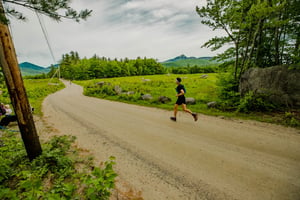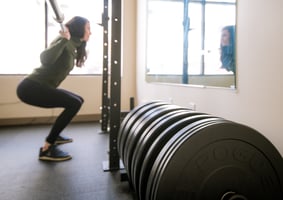At Steady State Health, we work with runners every day—whether they’re training for their next PR...
Heel-Striking: Is It Really Bad for You? Cadence for Runners
There are numerous running myths out there and many of them are related to running form. Probably the most common myth is that heel-striking is bad.
Landing with your heel hitting the ground first does place more stress on your knees. However landing with your toes hitting the ground first places more stress on your calf muscles, and therefore your achilles and plantar fascia.
So if you have a chronic history of knee issues with running, it certainly may be helpful to try to transition away from a heel-strike pattern and land more on your toes.
However, you must recognize that this only shifts where the loads are absorbed by your body.
If you have a chronic history of calf strains, achilles tendon issues, or plantar fasciitis, a heel-strike pattern would put less stress on your calf and therefore actually decrease your likelihood of reinjury.
Ultimately the bigger issue is typically where your foot hits the ground in relation to the rest of your body - not which part of your foot lands first.
Overstriding
80% of runners develop an injury every year. While there are numerous contributors to running injuries, overstriding is a common component.
Overstriding is when your foot makes initial contact with the ground relatively far out in front of you. When your foot lands far out in front of the rest of your body, every step is essentially like you are putting on the brakes. This creates more impact forces with each stride compared to if your foot were to initially contact the ground closer to underneath the rest of your body.
Newton’s third law of motion states that for every action there is an equal and opposite reaction. Every time your foot lands on the ground you place a certain amount of force into the ground - and the ground places an equal amount of force to your feet and legs.
Whether you heel-strike, land with your toes first, or land with your midfoot first, you can decrease the impact forces with each stride by shortening your stride in front of you. This decreases the load that you put into the ground, and therefore the amount of force the ground places on your legs.
It can be very challenging to learn to move your body in a different way, especially with such a repetitive motion like running. The longer you’ve been a runner the harder it is to change your running form.
Runners will spend a lot of money to have a gait analysis done to receive all kinds of information about their running form. While there are occasions where this can be extremely helpful, the most common significant finding with gait analyses done at Steady State is overstriding.
You can actually get a good sense of whether you overstride or not without having a formal gait analysis. There’s a common metric that you can track and alter that can help you prevent overstriding.
Cadence
Measuring and altering your cadence is the way that we’ve found best to decrease your stride length and therefore decrease the stress that your legs have to deal with with each step.
What is cadence?
Your running cadence is the total number of steps you take per minute while running at a given pace.
Your pace affects your cadence - typically the faster we run, the higher your cadence.
But too low of a cadence suggests that you are spending more time floating in the air while running and that your feet are likely landing too far out in front of you - aka overstriding.
“Okay, so what should my cadence be? Am I overstriding?”
For years it has been thought that 180 steps per minute (spm) is the ideal cadence - however this cannot be true.
Every runner is an individual. We each have a different body type, height, load tolerance, and amount of range of motion in our joints.
We like to start our cadence discussions with our clients by stating that world records in distance running events have been set with varying cadences, between 170-210 steps per minute. We can assume that world record holders are the most efficient athletes in the world.
Therefore there is a wide range of “most-efficient” cadences, and there is no magic number.
However, when someone’s cadence starts to get much below 170 spm, we start to consider making an adjustment if this individual is currently injured or has a more significant history of running injuries.
An Example
If you run with a GPS watch you can look back through your run info on Strava, Garmin, or Coros and look at your average cadence for each run.
It’s important to note that it is natural for our cadence to increase as we start to run at a faster pace. Most runners spend most of their time running at an easy pace, so we typically start by changing our cadence during the easy runs.
When looking through your cadence info for a given run, make sure you start with a run that was at an easy pace for the entire duration. If you had any periods of faster runner or you stopped and walked for a portion of the run, your average cadence will not be accurate for your typical easy running pace.
For our example let’s assume someone presents with an average cadence of 160 spm for their easy runs. How do we prescribe the increase in cadence?
Too much of a change too quickly can lead to a distribution of landing forces that are much different than your body is used to. This can actually increase the likelihood of an injury.
We typically recommend increasing cadence by a max of 5-7%.
So in our example above (160 * 0.05) + 160 = new cadence target of 168 steps per minute.
Okay so we’ve got our target cadence number and we’re ready to go for our next easy run.
What’s next?
Step 1 is downloading a free metronome app to your phone, or setting your GPS watch to beep to your target cadence.
Step 2 is matching your steps to the beat while running, while maintaining your typical easy running pace. This is the hardest part.
Typically when we try to increase our cadence, we start to run faster. This is why the most ideal environment to initially perform cadence training is on a treadmill.
On the treadmill you first set the speed to your typical easy run pace. Then all you have to think about is matching your steps to the beat.
This forces you to actually change your running stride.
This gets your foot to land more directly underneath you, rather than far out in front of you. This decreases the stress that your legs have to absorb with each stride, which helps to keep you pain-free!
Obviously no-one wants to run on the treadmill forever, so as your body adapts to its new form you can then start to wean out of the highly controlled environment.
With a slow enough transition you can eventually maintain your new cadence while running outside, at your same easy pace, without the need for the metronome.
We typically recommend doing your first 3-4 runs exclusively on the treadmill, with the metronome.
The first variable to fade is the metronome. First get to the point where you can run for 15-20 minutes keeping the appropriate cadence, while only needing to have the metronome playing for 1 minute out of every 4-5 minutes.
The next variable to change is the surface, progressing from the treadmill to outside running.
We typically recommend progressing to every-other-run being outside. Then progress to starting 1-2 runs per week on the treadmill for 5-10 minutes, followed by finishing the remaining portion of the run outside.
The final stage is for maintenance.
Every once and a while, return to the treadmill and use the metronome for a short period. Keep an eye on your average cadence numbers from your GPS watch and if they start to decrease, do a cadence training session sooner rather than later!
In summary:
- Heel-striking is not necessarily bad.
- Overstriding is the more common issue, no matter which position of the foot makes contact with the ground first.
- The easiest and most successful way to improve overstriding is by increasing your cadence, in increments of 5-7%.
- Increasing your cadence, without increasing your pace, is challenging to do without a highly controlled environment. Start with the highly controlled environment, then wean out of the treadmill and metronome feedback as you’re able.
Happy running!
-Kelton




